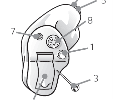IICs are the smallest and most discreet hearing aids available from Resound.5 As they are worn deep inside the ear canal, they provide a natural sound quality and are less likely to pick up wind noise than devices that sit behind your ear.

Whilst all hearing aids are designed to be as discreet as possible, those which fit inside the ear (rather than behind it) are the most subtle form available today.1,2 For this reason, invisible hearing aids are also commonly called ‘In-the-Canal’ hearing aids.
Resound make invisible hearing aids known as ‘Invisible-in-Canal’ or ‘IIC’ devices.3 To ensure they fit you precisely, these are custom made using a mould of your ear. These IICs provide a variety of features to enhance your hearing experience, and ultimately, your quality of life.2,4
IICs are the smallest and most discreet hearing aids available from Resound.5 As they are worn deep inside the ear canal, they provide a natural sound quality and are less likely to pick up wind noise than devices that sit behind your ear.
As part of the digital revolution of audiology, invisible hearing aids allow you to hear more of the sounds around you whilst being hardly noticeable in or around your ear. Everyone’s ears are different, so it’s important for a hearing professional (an audiologist or a hearing aid dispenser) to guide you through the next step to better hearing.3,6 Make an appointment today to find out whether invisible hearing aids are suitable for your needs and, if so, which kind will be best for you.
Invisible hearing aids are a great option for most people with mild to moderately hearing loss.1,2,4,5 Although this covers a wide range of hearing levels, it is important for a hearing professional (an audiologist or a hearing aid dispenser) to also assess the shape and size of your ear canal to ensure they will fit comfortably.4
Find your local hearing professional
Unfortunately, invisible hearing aids are not suitable for more severe or profound hearing losses due to their tiny size.2–4 They are also not recommended for people with permanent holes in their ear drums (‘perforations’), those who struggle with excessive ear wax production, or anyone who has undergone mastoid surgery.2 Discreetly designed Behind-the-Ear (BTE) hearing aids are slightly larger than invisible devices and therefore have room to house the extra powerful speakers and special features needed to support severe hearing losses.1,2
Hearing aids are designed to help you hear speech more clearly, rather than just making everything louder.4,7 People may feel ‘cut-off’, isolated or even depressed due to hearing loss.1,2,8 Hearing aids can improve your emotional and mental wellbeing by giving you the confidence to take part in everyday social situations and help you rebuild personal relationships.2–4,7–9
Invisible hearing aids are a great choice for people who would like discreet hearing aids; their tiny size has been associated with greater satisfaction and levels of use compared with larger devices.4,8,9
The tiny size of invisible hearing aids is both their biggest strength and weakness compared with Behind-the-Ear styles:
| After a little practice, invisible hearing aids are easy to take in and out, and to maintain.
Your hearing professional will demonstrate how to use them and provide you with written instructions to take home.10 You can also view our ‘how-to’ videos for help operating and cleaning your hearing aids. All ReSound hearing aids have colour-coded markings so, if you have a pair of hearing aids, you can easily determine which is for your left (blue) and right (red) ear.10 You may also want to consider asking your hearing professional to add a ‘stalk’ to help you put your hearing aids in and take them out more easily if you’re concerned. View the ‘how-to’ videos for help operating and maintaining your hearing aids |
 |
All ReSound hearing aid controls are easy to operate by touch alone.
Yes – all ReSound invisible hearing aids are custom made to ensure they fit comfortably in your ear. To ensure a precise fit to your ear, your hearing professional will either take a 3D scan of your ear or make an ear ‘impression’ (mould) using special silicone putty. The silicone putty is inserted into your ear to get a perfect copy of your ear anatomy. This may feel a bit odd, but it is not painful. Your personalised hearing aid is then made using the 3D scan or ear mould.
No – although they should be treated with the same care as other personal electronic items, such as mobile phones, to ensure they continue to work correctly.10,11 Invisible hearing aids need to be particularly robust as they spend most of their time in a ‘hostile’ environment for electronics.12 ReSound Invisible-in-Canal hearing aids have a special nanotech layer to protect them from moisture and ear wax.5,12 This patented coating is applied to the sensitive electronic components within the hearing aids, and has been proven to reduce the need for repairs and servicing.12 Here are some handy tips to help keep your hearing aid/s in the best condition possible:10
ReSound Invisible-in-Canal hearing aids (IICs) are not compatible with smartphones.
However, ReSound’s other custom hearing aids and many of their Behind-the-Ear styles integrate seamlessly with smartphones.13 They work with compatible iPhone, iPad and iPod touch devices as well as AndroidTM smartphones for direct streaming of calls, music and other audio, such as audiobooks or podcasts.13 It’s easy to check if your smartphone is compatible.
No – unfortunately ReSound Invisible-in-Canal hearing aids are too small to include rechargeable batteries.5
However, this is an ongoing area of development, and many ReSound Behind-the-Ear hearing aids are rechargeable.14 The invisible hearing aids that ReSound offer use zinc batteries, which are considered safer and more environmentally friendly than traditional lithium batteries.5,15,16
If you can’t wait to see a hearing care professional, you can start by taking our online hearing test today.



